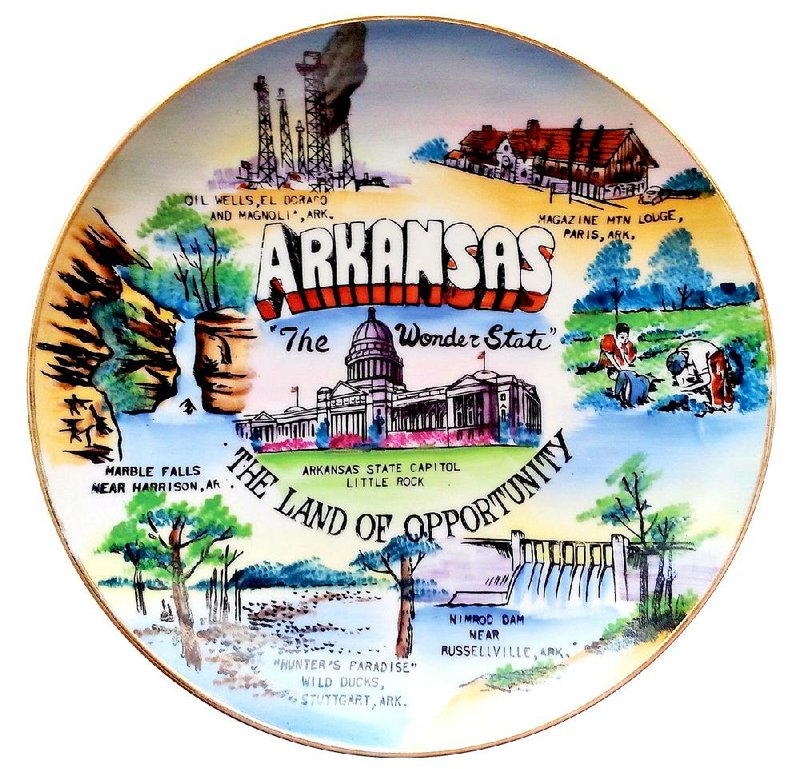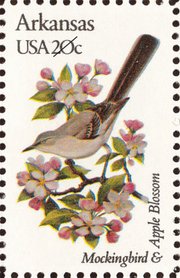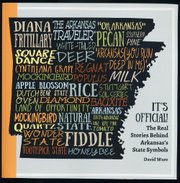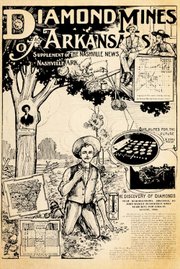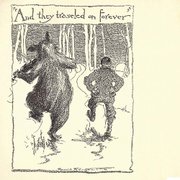Many things can be said about Arkansas, but some things are more than said -- in fact, they are legislated.
The state has 24 officially enacted symbols by historian David Ware's count, not including the Natural State's nickname and creed.
Ware describes the lot in his new book, It's Official! -- The Real Story Behind Arkansas's State Symbols, from Butler Center Books in Little Rock.
"The earliest state symbol was, in truth, a collection of them," Ware says -- the state seal, which in its first form appeared as the territorial seal as early as 1822. The state flag goes back to 1913, and the Legislature has been running more symbols up the flagpole ever since.
The state bird is the mockingbird. The state tree is the pine. The state grape is -- who knows? Anybody? Is there a hand up?
The state grape is the Cynthiana, not to be confused with the state grape of North Carolina, the scuppernong.
(And creed? The state creed is a statement of belief that starts, "I believe in Arkansas as a land of opportunity and promise," and goes on like that; and it's nowhere near as well-known as the fact that grapes make wine.)
Symbols "help define the state in the eyes of others -- that is, out-of-staters," Ware says. "Seen in this light, symbols are stand-ins for the state itself, things that distinguish it from its peers.
"I think, though, that state symbols may be more valuable internally, as keys to understanding the state's story and the forces that have shaped it.
"Taken together, the state's symbols encompass the mundane and the spiritual, workaday things and ambitious aspirations," he says. They teach "a love of, and a sense of responsibility toward, this state."
Some are as easy to pick up as the state nut:
the pecan. Some are as warmly appreciated as the state historic cooking vessel: the Dutch oven. Some are complicated. The state fruit and vegetable category, for example, "has a certain mystery to it," Ware writes.
The south Arkansas vine- ripe pink tomato is officially both -- the tomato being a fruit, technically, but a vegetable in the context of a bacon, lettuce and tomato sandwich.
This ignores that, scientifically, there is no such breed of tomato as "South Arkansas Vine Ripe Pink." Pass the salt.
"The designation raises hopes that any red or pink tomato may grow up to become an example of the state symbol," Ware writes -- so long as it's picked in the pink.
CAPITOL IDEA
Ware, 61, has been 15 years on the job as state Capitol historian in the secretary of state's office.
Arrived from Nebraska and Wyoming by way of Texas, he found Arkansas' state symbols a way to understand his family's new home.
"I spent the 1999-2000 academic year teaching at Arkansas Tech University and visiting various parts of the state," he says, ''getting to know a place I'd never been before. On the weekends, I'd load student papers to grade and my old Airedale, Sadie, into my truck and take off exploring. I suppose that you could say that I started my study of the state that year," finding symbols along the way.
"Symbols are seldom chosen inadvertently," he writes, and they don't just happen. They matter a lot to somebody, or else the honeybee never would have become the state insect.
"Designating a state symbol follows the same path as any bill on its way to becoming law," he says -- "introduction, referral to committee or committees, amendment and so forth."
A few set-tos have ensued along the way, notably the great apple blossom vs. passionflower wrestling bout for the title of state floral emblem. Winner by a cider press: the apple blossom.
"Usually, though, debate over symbol designation is good-natured," Ware says, "and sometimes has been the excuse for indulging in a bit of showy oratory."
That done, the process leads to "being approved by both chambers of our state Legislature and the governor."
And so, a toast of the state beverage, milk, to the state grain, rice, and the state butterfly, the Diana fritillary, all to a rousing chorus of the state song. All together, people -- sing out!
Hum-de-dum-dum, something-something. If the singalong seems to be going four ways at once, that's because it is.
As run through in Ware's book, and on the secretary of state's website (sos.arkansas.gov), Arkansas has no less than four state songs.
NAME THOSE TUNES
Ware holds that "a state song need not be a musical masterpiece in order to be memorable," and he says no fair poking fun at other states' noble, if clumsy, refrains.
(But really, Massachusetts. All hail to the grand old Bay State, the home of the bean and the cod! What were you thinking?)
Ware cites "The Arkansas Traveler" as the state's "first unofficial song," but the first official was music professor Eva Ware Barnett's "Arkansas" from 1916. It goes:
There the rice fields are full,
And the cotton, corn and hay,
There the fruits of the field
Bloom in the winter months and May.
Barnett's anthem gave way, sort of, to a 1940s modernized and never quite ratified version of "The Arkansas Traveler." It goes:
For the Wonder State, we'll sing a song
And lift our voices loud and long;
For the Wonder State, we'll shout "Hurrah!"
And praise the opportunities
We find in Arkansas.
Arkansas went by the nickname of "the Wonder State" in those bygone days. Before that, it went by "the Bear State" and "the Toothpick State" (in reference to the custom of carrying a big knife, such as a Bowie knife, also called an "Arkansas toothpick"). After, it was "the Land of Opportunity," and now "the Natural State."
But on with the music. Another state song is "Oh, Arkansas," by Terry Rose and Gary Klaff. It goes:
Oh, Arkansas, oh, Arkansas,
Arkansas U.S.A.
It's the spirit of friendship.
It's the spirit of hope,
It's the Razorbacks
Every game they play.
"Oh, Arkansas" celebrated the state's 150th birthday, in 1986, along with the fourth of Arkansas' state songs, Wayland Holyfield's "Arkansas (You Run Deep in Me)." It goes:
You're in my blood,
And I know you'll always be;
Arkansas, you run deep in me.
Since then, Ware finds "no serious effort" to introduce any more state songs. But considering the state musical instrument is the fiddle, the band could be ready for more.
CLASH OF SYMBOLS
"I think the most satisfying state symbols are those that reveal something unexpected about the state," Ware says: "the state grape, the state grain, gem [diamond] and even floral emblem fall into this category."
Just when a person might think he knows all there is to know about Arkansas, along comes a state symbol he probably didn't know.
The state is "full of surprises at every turn," Ware says, and here's a test to prove it:
The state rock is: (A) Southern rock, (B) quartz, or (C) bauxite.
The state folk dance is: (A) polka, (B) square dance, or (C) Ozark mountain hoedown.
The state soil is: (A) wet clay and sand, also known as "gumbo," (B) the Stuttgart soil series, or (C) dirt track dirt.
Answers: 1. (C) Bauxite, although quartz is close. Quartz is the state mineral. 2. (B), square dance. 3. (B) Stuttgart soil series, or what some people call "rice land."
Bonus question: What color tail does the official state mammal have? -- (A) black as a black bear's tail, (B) pink as a possum's or (C) white as a white-tailed deer's.
Answer: (C). The white-tailed deer is the state mammal, and the white underside of the deer's tail is what hunters see as the deer runs out of range.
SYMBOL OF TRIUMPH
The 200 pages of It's Official! have led Ware through the state's history of agriculture, pride, politics and popular culture, and the further symbolism embedded in the state flag and seal, and how to fry doughnuts in hot lard.
"In 16 years here I have barely scratched the surface of what [Arkansas] offers its residents and visitors alike," he says.
"If telling a few tales about the state symbols helps or encourages readers to take a closer look at the state, then I'll count the book a success."
Style on 01/17/2016
